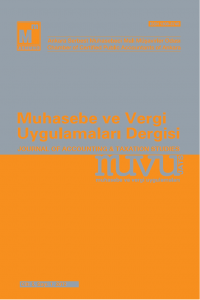Abstract
Son yıllarda özellikle de uluslar arası piyasalarda faaliyet gösteren şirketlerde
(Enron, Worldcum,Tyco International vb.) yaşanan bilgilerin güvenirliliği
sorunları iç denetimin katma değerini arttıracak yeni yaklaşımların
aranmasına neden olmuştur. Bu değişim sürecinde, klasik iç denetim yaklaşımlarından
vazgeçilerek, öncelikli amacı yüksek riskli alanlara yoğunlaşmak
olan Risk Odaklı İç Denetim yaklaşımına geçiş yapılmıştır. Şirketlerin
gelecekte karşılaşabileceği risklerin tespit edilmesi ve bu risklerin yönetilmesi
büyük bir önem taşımaktadır. Geleneksel denetim sürecinde sadece
şirketlerin mali tabloları geçmişe dönük olarak denetlenmekte idi. Ancak
sadece mali tablolara bakarak yatırımcılara işletmenin geleceği konusunda
yeterli bilgiler sağlanamamaktadır. Bu nedenle işletmenin içinde bulunduğu
risk derecesinin tespit edilmesi ve işletmenin bu durumdan en az
zararla kurtulmasını sağlayacak politikaların geliştirilmesi risk yönetimi ile
mümkün olabilecektir. Risk odaklı iç denetim faaliyeti, işletmenin başlıca
riskleri ve bu risklerin yönetilmesi üzerine odaklanan bir süreçtir. Bu nedenle
günümüzde iç denetim yönünü değiştirerek sadece geçmişle ilgili
kontrollerle ilgilenmek yerine, gelecekte organizasyonu bekleyen işletme
risklerine (operasyonel, stratejik, uygunluk, finansal, bilgi teknolojileri) de
odaklanmaya başlamıştır. Bu çalışmanın amacı, İMKB-İmalat Sanayi Endeksine
kayıtlı şirketlerde, risk odaklı iç denetimin uygulanmalarında iç
denetimin rolünü içeren risk faktörlerinin etkisini ölçmektir. Bu amaçla,
borsaya kote imalat sanayi şirketlerine bir anket yapılmış ve elde edilen
sonuçlar ANOVA tekniğiyle analiz edilmiştir. Bu çalışma sonucunda, İMKB
şirketlerinin büyük bir oranının iç denetim uygulamalarını risk odaklı yaptıklarını, fakat iç denetim uygulamalarında operasyonel ve bilgi teknolojileri
risk faktörlerini dikkate almadıkları sonucuna ulaşılmıştır.
References
- Uzun, Ali Kamil (2008), “İç Denetimin Etkinliğinde Başarı Faktörleri: Uygulama İçin Yol Haritası”, http://www.denetimnet.net/UserFiles/Documents/ Haberler/2008%2005%2029-KurumsalYonetimVeIcDenetim- AKUSunum2Basar%C4%B1Fak.pdf, (09.03.2012).
- Zwaan, L. D. and Stewart, J., (2011), “Internal Audit Involment in Enterprise Rsik Management”, Managerial Auditing Journal, Vol. 26, No. 7, pp. 586-604.
Abstract
In recent years, problems of the reliability of the information especially
in companies acting in international markets (Enron, Worldcum, Tyco International
etc.) has been led to search for new approaches to increase
the added value of internal audit. In this process of change, leaving the
traditional internal audit approaches, the risk based internal audit approach
which has the primary objective of focusing on high-risk areas was
transformed. To identify and manage the risks which companies will ecounter
in the future are very important. Throughout this traditional audit
process, only the financial statements of the companies were supervied
retrospectively. However, just looking at the financial statements, sufficient
information couldn’t be provided to investors about the future of the
enterprise. Therefore, development of policies to determine the risk degree
of the enterprise and to get rid of this situation by the least damage
will be possible with the risk management. Activity of risk based internal
audit is a process which focuses on the major risks and management of
these risks. For this reason, nowadays, internal audit began to focus on
the enterprise risks (operational, strategic, compliance, financial, information
technology) which has importance for the future of the organisation,
changing its direction, rather than dealing with just about controls in the
past. The aim of this study is to measure the impact of risk factors, including
the role of internal audit, on the applications of risk based internal
audit for the companies registered in Manufacturing Industry Index , Istanbul
Stock Exchange. For this purpose, a survey was applied to companies
coated in the manufacturing industry and the obtained results were
analyzed by ANOVA technique. As a result of this study, it has been cocluded
that a large proportion of ISE companies did internal audit practices
risk-based, whereas they did not take into account the risk factors of operational
and information technologies in their internal audit applications
References
- Uzun, Ali Kamil (2008), “İç Denetimin Etkinliğinde Başarı Faktörleri: Uygulama İçin Yol Haritası”, http://www.denetimnet.net/UserFiles/Documents/ Haberler/2008%2005%2029-KurumsalYonetimVeIcDenetim- AKUSunum2Basar%C4%B1Fak.pdf, (09.03.2012).
- Zwaan, L. D. and Stewart, J., (2011), “Internal Audit Involment in Enterprise Rsik Management”, Managerial Auditing Journal, Vol. 26, No. 7, pp. 586-604.
Details
| Primary Language | Turkish |
|---|---|
| Subjects | Business Administration |
| Journal Section | Issue |
| Authors | |
| Publication Date | March 1, 2012 |
| Submission Date | October 1, 2011 |
| Acceptance Date | January 1, 2012 |
| Published in Issue | Year 2012 Volume: 5 Issue: 1 |

This Journal Licensed under a Creative Commons Attribution-NonCommercial 4.0 International License.
This license allows reusers to distribute, remix, adapt, and build upon the material in any medium or format for noncommercial purposes only, and only so long as attribution is given to the creator.


